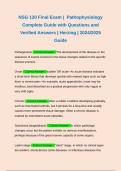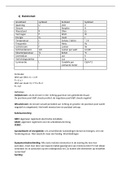NSG 120 Final Exam | Pathophysiology
Complete Guide with Questions and
Verified Answers | Herzing | 2024/2025
Guide
Pathogenesis - Correct Answer - The development of the disease or the
sequence of events involved in the tissue changes related to the specific
disease process.
Onset - Correct Answer - sudden OR acute- An acute disease indicates
a short-term illness that develops quickly with marked signs such as high
fever or severe pain—for example, acute appendicitis; onset may be
insidious, best described as a gradual progression with only vague or
very mild signs.
Chronic - Correct Answer - often a milder condition developing gradually,
such as rheumatoid arthritis, but it persists for a long time and usually
causes more permanent tissue damage. Often a chronic disease is
marked by intermittent acute episodes.
Subclinical (stage/phase) - Correct Answer - in which pathologic
changes occur but the patient exhibits no obvious manifestations,
perhaps because of the great reserve capacity of some organs.
Latent stage - Correct Answer - "silent" stage, in which no clinical signs
are evident, characterizes some diseases. In infectious diseases this
,stage may be referred to as the incubation period, which is the time
between exposure to the microorganism and the onset of signs or
symptoms; it may last for a day or so or may be prolonged, perhaps for
days or weeks.
Disease transmission of an insect bite - Correct Answer - The injury
occurs when the insect either bites or stings the patient. Venom is
injected into the tissue, resulting in the body's response to a foreign
protein.
Lymes Etiology - Correct Answer - Lyme disease is an infectious disease
caused by the spirochete bacterium. Ticks that bite the skin spread Lyme
disease by injecting the bacterium from their gut into the human body
when securing a blood meal. Lyme disease can affect the skin, joints,
heart, and nervous system.
Lymes S&S - Correct Answer - Approximately half of all patients with
Lyme disease have a characteristic red, itchy rash with a red circle
center resembling the bull's eye on a target.
Lyme disease can masquerade as arthritis and cause influenza-like
symptoms, such as headache, fever, fatigue, joint pain, and general
malaise.
late complications of muscle weakness, paralysis, and neurologic
conditions (e.g., learning difficulties, excessive fatigue, and muscle
coordination problems) can develop.
,Diabetes Type I - Correct Answer - *early, abrupt onset usually before 30
years of age
*Little or no insulin being secreted by patient
*Can be difficult to control
*Requires insulin replacement
*Typically congenital
Diabetes Type II - Correct Answer - *most common form; gradual onset
in adults older than 30
*Pancreatic function remains permitting control of symptoms by dietary
management
*Insulin resistance
Hypoglycemia - Correct Answer - abnormally low glucose level in blood
Caused by insulin overdose in diabetic subject, high blood alcohol levels,
sulfonylureas, fasting, delayed or excessive secretion of insulin,
adenoma or carcinoma of pancreas, GI disorders, or genes
Condition occurs despite adequate food intake
Symptoms include sweating, nervousness, weakness, hunger, dizziness,
trembling, headache, and palpitations
Can cause problems in CNS
DKA (diabetic ketoacidosis) - Correct Answer - Shortage of insulin
resulting in hyperglycemia and production of ketones.
, Results from insufficient insulin which leads to high blood glucose levels
and mobilization of lipids.\
More common in type 1 patients
S/S include dehydration, metabolic acidosis, and electrolyte imbalances
HHS (hyperosmolar hyperglycemic nonketotic coma): - Correct Answer -
Body is using insulin more than anticipated
Hyperglycemia and dehydration develop
More common in type 2 patients
Acromegaly - Correct Answer - Chronic metabolic condition of adults
caused by hypersecretion of GH by pituitary gland.
Causes: pituitary tumor or adenoma is often cause
Affects men and women equally
Gigantism - Correct Answer - abnormal pattern of growth and stature
Causes: Anterior pituitary adenoma is often cause of over secretion of
GH that results in gigantism
SIADH (Syndrome of Inappropriate Antidiuretic Hormone Secretion): -
Correct Answer - Excess ADH which causes fluid retention
Causes:
Stress (temporary SIADH)





